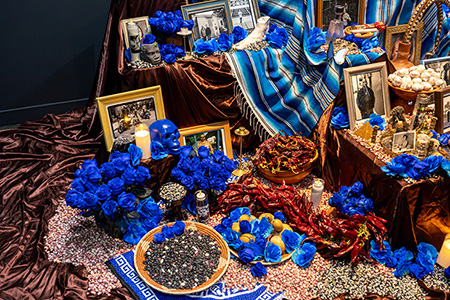
Continuing through February 25, 2024
Over the past several years, Anaheim’s Muzeo Museum and Cultural Center has fashioned itself into an anomaly among Orange County museums and galleries, presenting exhibitions that address diversity, civil rights, social justice and daily life among SoCal’s people of color.
In 2017, the venue mounted “Deconstructing Liberty: A Destiny,” depicting the subversion of liberty in Latin American countries and Puerto Rico, and maddressing American liberty, patriotism, community, the pursuit of happiness, freedom, equal rights, and activism.
In 2019, the museum displayed “Papel Chicano Dos” from the Cheech Marin Collection. Featuring work by Gilbert Lujan, Frank Romero, Carlos Almaraz and lesser-known artists, the exhibition brought viewers into a world of activism, community support and Chicano ancestral history as the foundation for politically charged artworks.
In 2021, the Muzeo exhibited “For All the World to See: Visual Culture and the Struggle for Civil Rights.” Previously displayed as a larger show at the National Museum of African American History, it visually documented the profound impact that images in the media and advertising (including a 1950s Aunt Jemima syrup dispenser) have on our perception of race.
With the current exhibition, “Traditions, Honoring Heritage, Ritual, and Family” the venue presents two dozen plus artists of color who have roots in or connections with Southern California arts, culture, and life. Curated by L.A.’s Thinkspace Projects and Tlaloc Studios, the show presents the rituals and heritages of a mostly millennial generation of artists. Consisting mostly of works created in the last two years, the show is a stroll through the vibrant, expressive worlds that these residents inhabit.
The mixed media drawings, paintings, photos and sculptures depict the artists’ daily lives on the streets, in their homes with their friends and families, engaging with their love of games, parties, music, car culture, graffiti and tattoo art.
Jimmy Bonks’ “Sharky’s Billiard” with its fierce billiard players with frog faces and blue barmaid with three breasts, pays homage to the original Señor Frog’s bar and restaurant in Mazatlán, Mexico. This large, humorous painting also references the fun-loving Sharky’s Billiards in Sacramento.
Jonni Cheatwood’s two oil and acrylic on sewn textiles, “Shrimp Jazz, Chicken Jazz, Alimony Stew” and “A Cat Named Moses,” feature vibrant colors and well-constructed images of fun-loving young men. Within each painting, the faces are obscured so as to render each face unrecognizable. Their anonymity references the dismissal of immigrants by increasingly proactive white supremacists.
Graffiti, tattoo artist and sign painter Daniel Antelo’s hyper-realistic oil “Baldacci” is a testament to the beauty and significance of tattoos. And as a striking self-portrait, it reveals several tattooed teardrops under the artist’s eyes, symbols associated with gang and prison culture as well as with sorrow and loss.
Erick Medel’s colorful polyester thread on denim "For the Audience (Globos con audiencia),” depicting a balloon salesman, and “Señora con los helados (Santee Alley Ice Cream),” a scene from L.A.’s downtown and downscale fashion district, present recollections of the artist’s childhood. Painted on fabric, they extol his immigrant parents from Mexico performing their work.
Other notable works in this show celebrating family life include Jacqueline Valenzuela’s portrait “I’ll Always Love My Momma;” Michael Vasquez’s compassionate “Father and Son Sundays (Pride in Ownership),” a boy and father washing the family car; and Floyd Strickland’s magnificently rendered “Brother’s Keeper,” two young brothers protecting each other with their backs adjoining.
The most elaborate individual work here is Esteva Oriol’s installation "In Loving Memory: SPANTO,” a Day of the Dead memorial to his friend. The altar, replete with chiles, garlic, bulbs, flowers, skulls, and photos of lost friends, is surrounded by more photos on the walls, all shot by the 56-year-old photographer.
